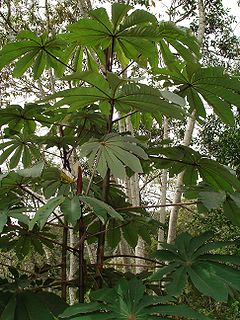
Cecropia is a Neotropical genus consisting of 61 recognized species with a highly distinctive lineage of dioecious trees. The genus consists of pioneer trees in the more or less humid parts of the Neotropics, with the majority of the species being myrmecophytic. Berg and Rosselli state that the genus is characterized by some unusual traits: spathes fully enclosing the flower-bearing parts of the inflorescences until anthesis, patches of dense indumentums (trichilia) producing Mullerian (food) at the base of the petiole, and anthers becoming detached at anthesis. Cecropia is most studied for its ecological role and association with ants. Its classification is controversial; in the past, it has been placed in the Cecropiaceae, Moraceae, or Urticaceae. The modern Angiosperm Phylogeny Group system places the "cecropiacean" group in the Urticaceae.

The pileated woodpecker is a large, mostly black woodpecker native to North America. An insectivore, it inhabits deciduous forests in eastern North America, the Great Lakes, the boreal forests of Canada, and parts of the Pacific Coast. It is the largest extant woodpecker species in the United States.

Myrmecophytes are plants that live in a mutualistic association with a colony of ants. There are over 100 different genera of myrmecophytes. These plants possess structural adaptations that provide ants with food and/or shelter. These specialized structures include domatia, food bodies, and extrafloral nectaries. In exchange for food and shelter, ants aid the myrmecophyte in pollination, seed dispersal, gathering of essential nutrients, and/or defense. Specifically, domatia adapted to ants may be called myrmecodomatia.
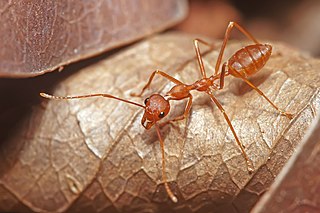
Oecophylla smaragdina is a species of arboreal ant found in tropical Asia and Australia. These ants form colonies with multiple nests in trees, each nest being made of leaves stitched together using the silk produced by the ant larvae.

Myrmecophily is the term applied to positive interspecies associations between ants and a variety of other organisms, such as plants, other arthropods, and fungi. Myrmecophily refers to mutualistic associations with ants, though in its more general use, the term may also refer to commensal or even parasitic interactions.

A tree hollow or tree hole is a semi-enclosed cavity which has naturally formed in the trunk or branch of a tree. They are found mainly in old trees, whether living or not. Hollows form in many species of trees, and are a prominent feature of natural forests and woodlands, and act as a resource or habitat for a number of vertebrate and invertebrate animals.

Acromyrmex is a genus of New World ants of the subfamily Myrmicinae. This genus is found in South America and parts of Central America and the Caribbean Islands, and contains 33 known species. Commonly known as "leafcutter ants" they comprise one of the two genera of advanced attines within the tribe Attini, along with Atta.

Tetraponera is a genus of ants in the subfamily Pseudomyrmecinae that are commonly known as slender ants and are characterized by their arboreal nature and slender bodies. The 86 described species of Tetraponera all live in hollow structures of plants and trees, such as thorns or branches; these hosts are known as myrmecophytes. Tetraponera species are closely related to the New World genus of ants Pseudomyrmex, but differ in their relationships with host plants.

Euprenolepis procera is a species of ant found in the rainforests of South East Asia. It was first described by Carlo Emery, an Italian entomologist, in 1900. In 2008, Witte & Maschwitz discovered that E. procera specialises in harvesting mushrooms in the rainforest for food, representing a new, previously unreported feeding strategy in ants.
Colobopsis anderseni, synonym Camponotus anderseni, is a species of mangrove ant found in northern Australia.
Azteca andreae is an arboreal ant species found in the tropics of South America, most notably in French Guiana. They are most notable for their predatory skills and strength. They are ambush predators that are able to capture and eat other insects much greater than their own size.
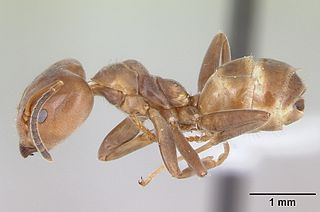
Azteca is a strictly Neotropical genus of ants in the subfamily Dolichoderinae. The genus is very diverse and contains around 84 extant species and two fossil species. They are essentially arboreal and many species have mutualistic associations with particular plant species, where the genus Cecropia presents the most conspicuous association. In the Brazilian Amazonia, Azteca species are associated with species of Codonanthopsis.

Daceton armigerum is a Neotropical species of arboreal ants, distributed throughout northern South America. D. armigerum combines several traits generally noted in some other arboreal ants i.e., populous colonies, large and/or polydomous nests, intra- and interspecific aggressiveness, trophobiosis, and capturing prey by spread-eagling them.
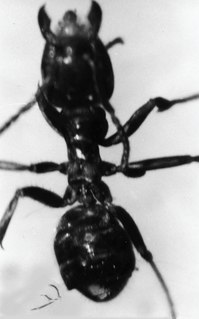
Azteca alpha is an extinct species of ant in the subfamily Dolichoderinae known from possibly Miocene fossils found on Hispaniola. A. alpha is one of only two species in the genus Azteca to have been described from fossils, both found in Dominican amber. It is the host for a fossil nematode, and has been preserved with scale insects.

Azteca alfari is a species of ant in the genus Azteca. Described by Carlo Emery in 1893, the species is widespread in Mexico, Central and South America. This ant has a mutualistic relationship with a Cecropia tree. The specific name alfari honours a Costa Rican zoologist Anastasio Alfaro.

Pleometrosis is a behavior observed in social insects where colony formation is initiated by multiple queens primarily by the same species of insect. This type of behavior has been mainly studied in ants but also occurs in wasps, bees, and termites. This behavior is of significant interest to scientists particularly in ants and termites because nest formation often happens between queens that are unrelated, ruling out the argument of inclusive fitness as the driving force of pleometrosis. Whereas in other species such as wasps and bees co-founding queens are often related. The majority of species that engage in pleometrosis after the initial stages of colony formation will reduce their colonies number of queens down to one dominant queen and either kill or push out the supernumerary queens. However there are some cases where pleometrosis-formed colonies keep multiple queens for longer than the early stages of colony growth. Multiple queens can help to speed a colony through the early stages of colony growth by producing a larger worker ant population faster which helps to out-compete other colonies in colony-dense areas. However forming colonies with multiple queens can also cause intra-colony competition between the queens possibly lowering the likelihood of survival of a queen in a pleometrotic colony.
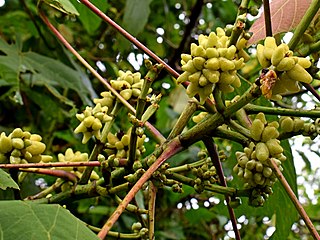
Macaranga triloba is a species of plant in the family Euphorbiaceae. It is native to the tropical forests of southeastern Asia. It is a pioneer species, colonising recently cleared or burnt areas of the forest.
Tetraponera tessmanni is a species of ant in the subfamily Pseudomyrmecinae, which is native to tropical Central Africa, where it inhabits the hollow stems of the liana Vitex thyrsiflora.
Coelomera ruficornis is a species of beetle in the family Chrysomelidae. It is found in tropical South America where it feeds on Cecropia pachystachya trees.

Cecropia pachystachya, commonly known as Ambay pumpwood, is a species of tree in the family Urticaceae. It is native to Argentina, Paraguay and Brazil where it grows near the edges of moist forests.
















